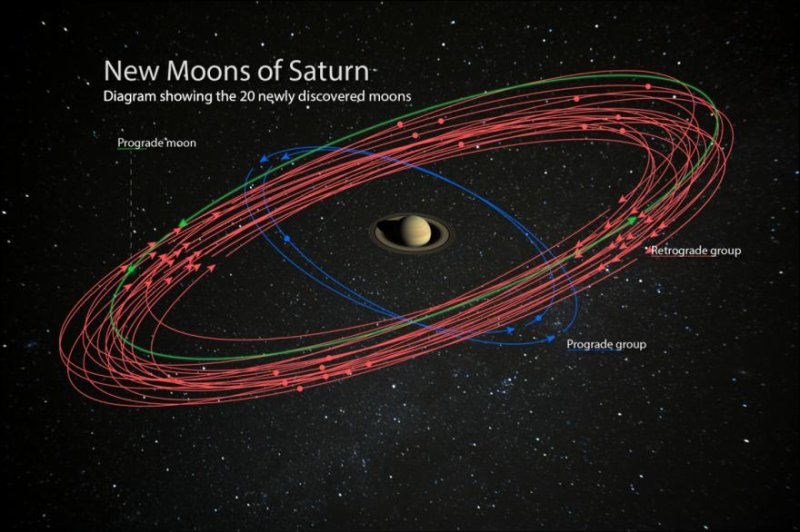The diagram shows the orbits of the 20 new moons found around Saturn. The red lines represent retrograde orbits, while the green and blue represent prograde orbits. Photo by NASA/JPL-Caltech/Space Science Institute
Oct. 9 (UPI) -- Move over Jupiter, Saturn is now the most moon-rich planet in the solar system. This week, astronomers at the Carnegie Institution for Science announced the discovery of 20 new moons around Saturn.
"Using some of the largest telescopes in the world, we are now completing the inventory of small moons around the giant planets," lead researcher Scott S. Sheppard said in a news release. "They play a crucial role in helping us determine how our solar system's planets formed and evolved."
Scientists spotted the novel lunar transits using the Subaru telescope that sits atop Mauna Kea in Hawaii.
The discovery comes roughly a year after scientists announced the presence of 12 new moons around Jupiter. Last year's discovery brought Jupiter's moon population to 79. But with the latest findings, Saturn can now claim 82 natural satellites.
Not surprisingly, the new moons are all quite small, most boasting a diameter of roughly three miles. Seventeen of the new moons orbit in retrograde, or in the opposite direction of Saturn's rotation around its axis. Two of the three prograde moons are located closer to Saturn and take two years to orbit the giant planet, while the rest take at least three years to complete an orbit.
"Studying the orbits of these moons can reveal their origins, as well as information about the conditions surrounding Saturn at the time of its formation," Sheppard said.
Scientists grouped the moons into three different clusters. The retrograde moons belong to the Norse group, with names coming from Norse mythology, a group that astronomers estimate was produced by the breakup of a larger moon. One of the retrograde moons is the farthest known moon orbiting Saturn.
"This kind of grouping of outer moons is also seen around Jupiter, indicating violent collisions occurred between moons in the Saturnian system or with outside objects such as passing asteroids or comets," Sheppard said.
The new moons will all get their own names, and scientists have called on the public for help. Anyone can offer name suggestions through Dec. 6.















